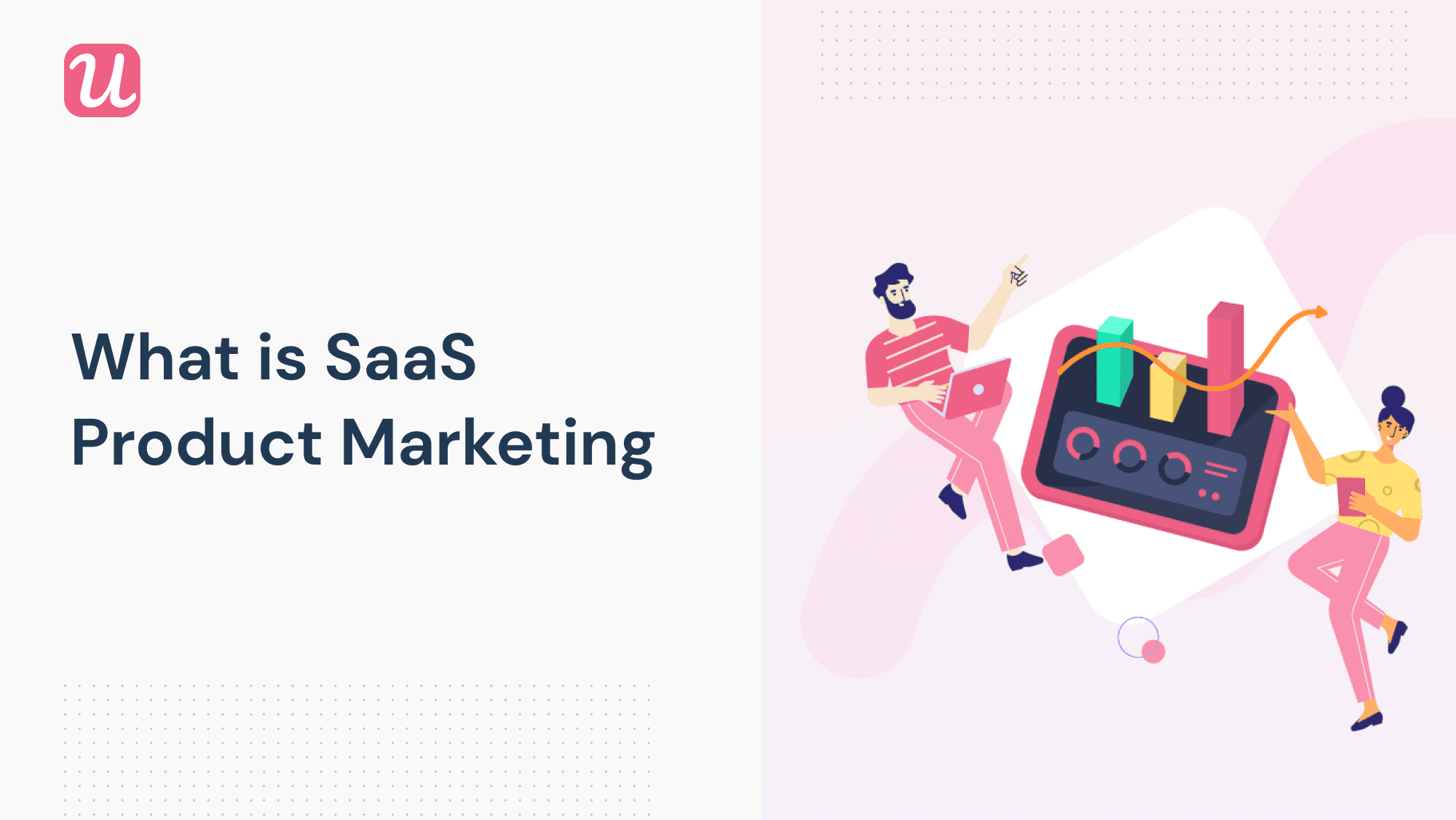
Despite its growing popularity, many people are still unfamiliar with SaaS product marketing.
A common question is: what is SaaS product marketing? And how is it different from traditional marketing? Most importantly, how does it benefit your SaaS business?
In this post, I will give you an overview of what SaaS product marketing is and what it entails.
Try Userpilot Now
See Why 1,000+ Teams Choose Userpilot

What is SaaS product marketing?
SaaS product marketing is a service that’s applied to SaaS products and apps to generate demand and ultimately drive the adoption and retention of the product by the end-user.
It’s about constantly delivering value to users while focusing on reducing churn and increasing account expansion.
SaaS product marketing vs. traditional marketing
Traditional marketing focuses on acquiring marketing qualified leads (MQLs) for the sales team, who then take the job from there.
In contrast, SaaS product marketing focuses on growing the product by onboarding in-app and mobile users across all stages of the user journey.
To put it in context, let’s view them separately.
Traditional marketing:
- Sits at the intersection of product, marketing, and sales
- Builds messaging and positioning for products and services
- Focuses on creating demand and acquiring MQLs for the sales team
SaaS product marketing:
- Uses product as the primary driver of acquisition by offering a free trial and freemium models (in product-led SaaS marketing)
- Builds message and positioning for products and services
- Responsible for driving product growth by onboarding users across all stages of their journey.
What is the role of SaaS product marketing? How does it fit within your company?
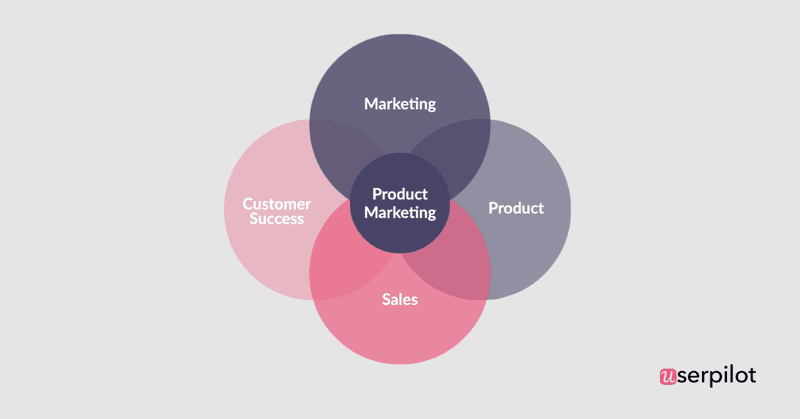
Product marketing in SaaS is responsible for driving demand, adoption, retention, and account expansion of a product in a continuous circle.
But as SaaS products change often with new feature introduction and UI changes it is the role of product marketing to:
- Onboard users continuously
- Increase user adoption
- Reduce churn
- Identify opportunities for and drive account expansion
What should your SaaS product marketing team look like?
Many factors will influence what your product marketing team looks like, e.g. the size of your company, the nature of your product/service, and your in-house capacity.
To build a product marketing team in SaaS, you first need to ask yourself:
- Do you rely on your sales team to convert trial users into paying customers or are you using a product-led approach?
- Can you justify the cost of your product marketing team? – early-stage SaaS can be flexible and marketing teams and product managers can cover the product marketing part
In any case, a good start for a product marketing team would be to hire (depending on your business size):
- Head of product marketing (Product Marketing Manager)
- Growth product marketer (for in-app marketing)
- Head of content marketing
- An SEO marketer
What does a SaaS product marketing manager do?
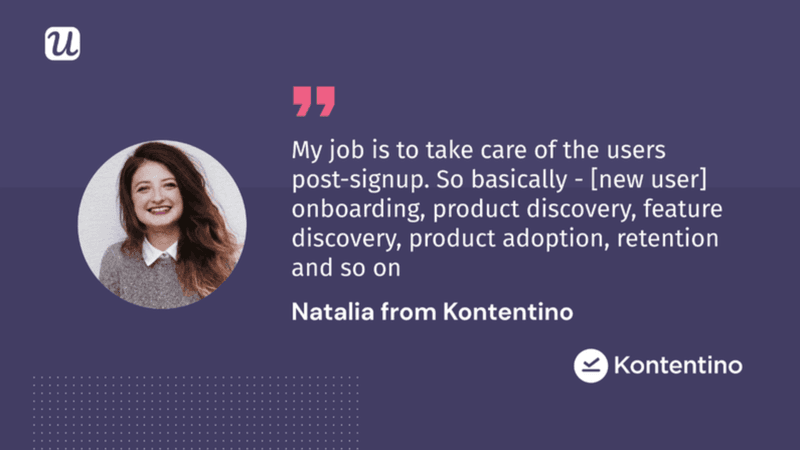
The bulk of the work for a marketing manager does occur post-signup, so much so that we’ve nearly forgotten to mention activities that occur outside the app!
To make it easier, we can say that a product marketing manager is responsible for:
- Pre-onboarding responsibilities: define product positioning and communicate the value of the product in a clear and credible way, to drive trial signups
- Onboarding responsibilities: help trial users realize and experience the value of the product
- Account expansion responsibilities: get customers to expand their accounts through upselling and cross-selling
Check the detailed guide we created on the role and responsibilities of a product marketing manager throughout all stages.
What does a SaaS product marketing strategy look like?
Unlike traditional product marketing, which focuses more on pre-launch activities, SaaS product marketing strategy has two phases: the pre-launch marketing strategy and the post-launch marketing strategy.
The pre-launch product marketing strategy’s objective is to take a product to market to get free trial acquisitions using a series of tactics laid down in a comprehensive go-to-market strategy.
Whereas, a post-launch product marketing strategy focuses on helping users realize their objectives with the product and nurtures them from one stage to another in their customer journey, i.e from free trial signup to brand advocate.
Let’s see what each strategy covers.
Pre-launch SaaS product marketing strategy
The goal of a pre-launch SaaS product marketing strategy is to acquire trial users.
Here’s a summary of what a go-to-market strategy might include:
1. Product positioning
In the words of April Donfurd, the author of Obviously Awesome: How to Nail Product Positioning so Customers Get It, By It, Love It:
Product positioning “defines how your product is a leader at delivering something that a well-defined set of customers cares a lot about.”
Your product has to be for a specific group of people whose problem it solves better than any other product.
2. Competitors and market alternatives
Competitors are other SaaS businesses that offer the same services as your SaaS product does. Think Active Campaign and Mailchimp, both offer email marketing automation.
Alternatives are the other options someone can use to solve their problems, e.g. you can write a blog post using any of these: Notion, Google Docs, and StoryChief. But those are actually three separate tools build for different purposes.
It’s important to identify your competitors so you can work on explaining what makes you different.
3. Customer persona
Customer persona represents the type of people that are most likely to benefit from your product.
You can identify them by conducting research and gathering both qualitative and quantitative data collected through user interviews and surveys.
The things you should focus on when building your persona are:
- the JTBD
- how does the company for which they work look like
- Pain points and challenges in achieving the job to be done
- what are the gains of using your product compared to alternatives and competitors
4. Customer journey
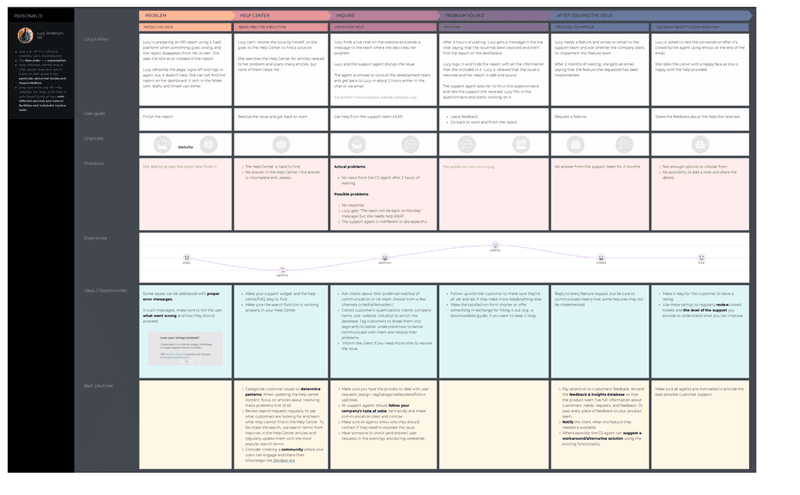
The customer journey in SaaS is a map of all the interactions a customer will have with your brand before deciding to sign up for a free trial.
This covers awareness, consideration, evaluation of alternatives, and decision stages. It also includes the channels they’ll take and the touchpoints in their customer journey.
The user journey starts where the customer journey ends, but we will discuss more on that later.
5. Budgets, goals, and KPIs
Goals are what you are trying to achieve and KPIs are what helps you measure how close you are to achieving them.
There is a bunch of relevant product marketing KPIs you can track, but make sure to start with a clear goal in mind-this will help you understand which KPIs you need to look at.
6. Tactics and channels
In SaaS, marketing will take a series of tactics performed across different channels. Each of these tactics and phases comes with different costs and results.
That’s why the best practice is to focus on one tactic at a time and scale when your business scales.
For example, you can start your marketing effort by driving acquisition through organic traffic.
If that method works well, you already know that you have a market you can serve, then you can add paid traffic to increase the number of trials and demo requests you’ve been driving with content marketing.
Post-launch SaaS product marketing strategy
The objective of pro-launch product marketing in SaaS is to nurture signups from one stage to another by optimizing the onboarding process or mobile onboarding with the goal of increasing key metrics in the Pirate Metrics Framework.
SaaS product marketing strategy in the post-launch phase relies to a large extent on marketing automation.
To get it right, you need to first understand how the user journey stages apply to your product. Let’s go through them one by one.
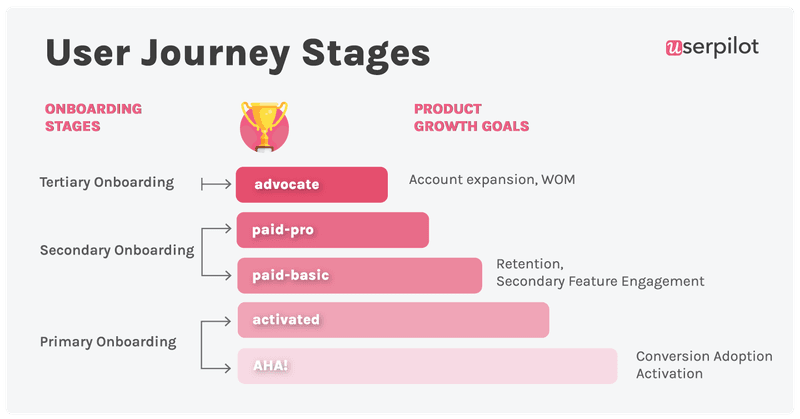
Primary onboarding
In the primary onboarding stage, the goal is to get your users to understand and experience the value of your product by getting them to the “Aha! moment” and reaching the activation stage.
To reach this point, a user would have completed a number of key actions in your product that gets them to experience the value.
For example, if you offer an email marketing automation tool, for a user to activate, they would have to complete the following tasks:
- Install a JS tracking code on their website
- Uploaded a list of contact to the email tool
- Created their first email campaign
- Sent their first email
Secondary onboarding
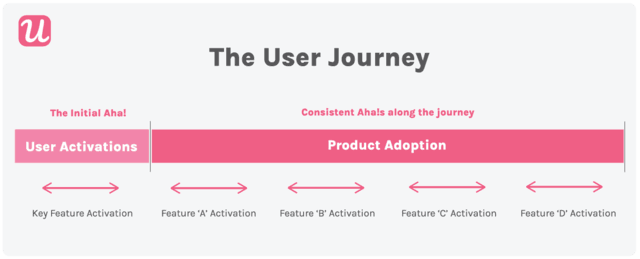
In the secondary onboarding stage, you introduce users to secondary features of your product that show them more ways of how they can benefit from your product.
Tertiary onboarding
Tertiary onboarding is about retaining users and driving account expansion.
This is the stage in the user journey where users understood and experienced the value your product provides, became paying users, and are comfortable using most features of your product.
SaaS product marketing automation
Marketing automation is the process of using software and technologies specifically designed for product marketers to automate repetitive tasks.
If you look at the scope of the work needed in the post-launch SaaS marketing strategy, you’ll notice that there are too many repetitive tasks that need to be done at a speed humans are not programmed for.
For example, you need to send an email each time someone signs up. If you are getting your pre-launch goals right, you’ll have many signups daily. Cost-wise, it doesn’t make much sense to not use marketing automation.
Automating these tasks will eliminate human error and offer a consistent personalized experience for all users.
How to build a simple product marketing automation strategy for SaaS
The major reason for using marketing automation is to take your users from one stage of their journey to another. To do that you first need to build a marketing automation strategy.
Here’s how to do it in 5 easy steps:
- Map user journey stages: these will vary based on the user persona and use case
- Identify tasks that need to be automated at each stage: these are usually the most repetitive tasks that you couldn’t do manually (signup emails, onboarding, feature launches, etc)
- Set clear goals: what exactly are you trying to achieve by automating specific tasks? (increase activation, improve retention, reduce churn, etc)
- Choose the right tool: consider the goal and the channel where you will be interacting with the user before deciding on which tool is best
- Measure and improve: set KPIs for each goal, track them, and run A/B tests to test different experiences and improve
SaaS product marketing automation tools
As mentioned above, there are multiple marketing automation software tools, each built with a clear purpose in mind.
When looking to choose which one is right for you, start with the goal and channel.
We’ve written an extensive article on this. Here is a checklist of the tasks you can automate and the best tools you can use to do that (I recommend you read the full article if you’re looking to understand the unique aspects of each of these tools!)
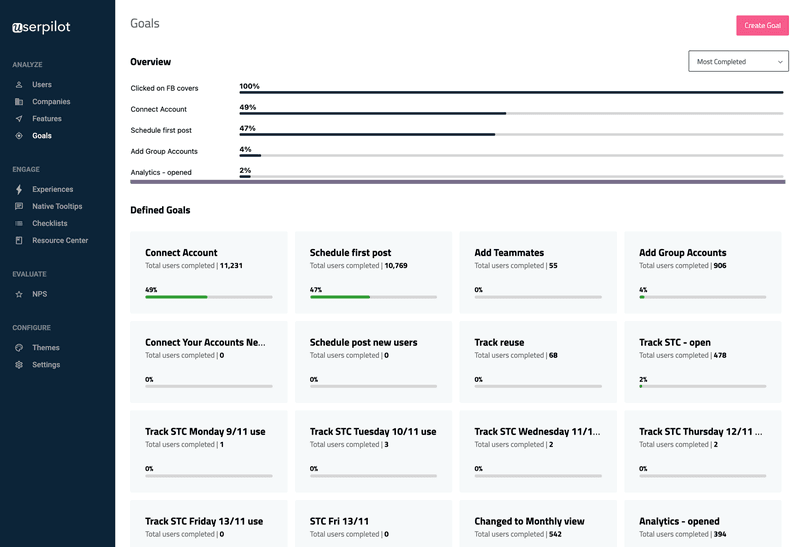
- Email: ActiveCampaign, Customer.io, Drip
- Self-Serve support: Userpilot, Intercom, Zendesk
- User communication: Hubspot chatbot, Intercom chatbot, Drift chatbot
- Social media: Kontentino, Buffer, Hootsuite
- Paid channels: AdRoll, Adzooma, AdExpresso
How to measure the impact of SaaS product marketing
Measuring product marketing success in SaaS is done by setting key performance indicators (KPIs) to track at each stage in the customer journey.
In SaaS, using the Pirate Metrics framework is the most popular way of tracking the impact of your product marketing.
Put simply, pirate metrics is a system for grouping and tracking metrics across different stages of the user journey: acquisition, activation, adoption, retention, and revenue(referral).
In short – AAARR.
Here are some important metrics you should look at in each stage:
- Customer Journey KPIs to track: conversion rates and velocity metrics
- Acquisition stage KPIs to track: CAC or Demos booked
- Activation stage KPIs to track: Activation Rate, Average Time to Value
- Adoption stage KPIs to track: Active User, DAU to MAU ratio, Feature Adoption Rate
- Retention stage KPIs to track: Customer Churn, Revenue Churn, LTV, LTV to CAC ratio, User Retention Rate
- Revenue (Referral) stage KPIs to track: NPS
- Mobile app KPIs to track: User Behavior, Engagement, and Retention
Conclusion
You should now have a basic understanding of what SaaS product marketing is.
If you’re looking into implementing post-launch product marketing activities and drive product adoption, you should definitely give Userpilot a try.
There’s no easier and faster way of building in-app and mobile onboarding experiences without coding. Get a Userpilot demo and learn how.






